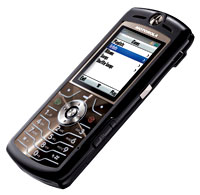 Four months after releasing their first iTunes-enabled mobile phone, the disappointing Motorola ROKR E1, Motorola have had another stab at creating the perfect music phone.
Four months after releasing their first iTunes-enabled mobile phone, the disappointing Motorola ROKR E1, Motorola have had another stab at creating the perfect music phone.
Their new, none-more-black SLVR L7 is a slinky non-folding affair, with a design reminiscent of the box-shifting RAZR clamshell phone.
Motorola are hoping that that the new handset will go down better than the ROKR E1, whose well documented shortcomings pinned sales around the 84,000 mark last year – compare that figure to the tens of millions of RAZRs that flew off the shelves in the same period.
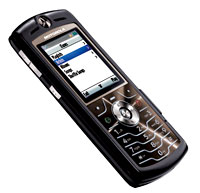 The biggest complaint was the laughably feeble memory on the ROKR that could only hold a maximum of 100 iTunes songs – regardless of memory capacity – and a treacle-slow song transfer rate.
The biggest complaint was the laughably feeble memory on the ROKR that could only hold a maximum of 100 iTunes songs – regardless of memory capacity – and a treacle-slow song transfer rate.
Crazily, the SLVR L7 doesn’t fix these sales-losing issues, and comes with the same ridiculous storage limitation for iTunes files and the same Ye Olde Super-Slowe USB 1.1 connection.
Someone’s ‘avin’ a laugh, surely?
Looking at the spec sheets, things get even worse, with the handset lacking the useful music-oriented features seen on the ROKR – there’s no external stereo speakers or dedicated headphone jack, so ‘phones have to be plugged into the charging jack via an adapter. And that’s rubbish.
At least the L7 looks a lot better than its predecessor, with a glass-infused plastic case, anodised aluminium back, stylish flat-keypad design and a large, 176×220, 262k-colour screen.
The pocketable quad-band handset (1.93″ x 4.47″ x 0.45″) also comes with a VGA camera, TransFlash memory card slot and Bluetooth (but not for listening to music).
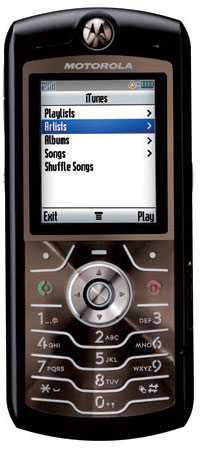 In a flurry of arty waffle, Steve Lalla, vice president and general manager for mass-market products at Motorola, explained that the, “L7 is really in what we call our ‘self-expression portfolio,’ where design and style is the key premise behind the product”.
In a flurry of arty waffle, Steve Lalla, vice president and general manager for mass-market products at Motorola, explained that the, “L7 is really in what we call our ‘self-expression portfolio,’ where design and style is the key premise behind the product”.
We suspect punters would have been far happier if they’d just designed away the ridiculous 100-song limit instead,
The Motorola SLVR is expected to be available in Q3 2005. Pricing to be announced.
SPECIFICATIONS: Sleek, super-thin design without sacrificing advanced functionality
PTT with icon presence indicators for one-touch connections
Integrated VGA camera with 4x zoom and video capture and playback
Bluetooth Class 2 for hands-free connectivity
MP3 player to store, repeat, shuffle and play favorite tunes; 22Khz polyphonic speaker
Up to 512 MB or removable TransFlash memoryWAP 2.0
Downloadable wallpaper, screensaver and MP3 ringtones
J2ME™ MIDP 2.0
Integrated hands-free speakerphone
Messaging via MMS*, IM Wireless Village* and email (POP3, SMTP)
Motorola’s SCREEN3 technology solution featuring zero-click access to news, sports, entertainment, and other premium content.
 A week ahead of its scheduled launch, smartphone bigwigs i-mate have revealed details of their latest model, the JAMin.
A week ahead of its scheduled launch, smartphone bigwigs i-mate have revealed details of their latest model, the JAMin.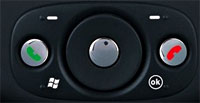 Switching from a 416 MHz Intel processor to a 200 MHz TI processor (we know it sounds like it must be slower but they’re not directly comparable), i-mate have stuck with the JAM form factor, adding a different button layout and twice the ROM.
Switching from a 416 MHz Intel processor to a 200 MHz TI processor (we know it sounds like it must be slower but they’re not directly comparable), i-mate have stuck with the JAM form factor, adding a different button layout and twice the ROM. Also known as the HTC Prophet (and O2 XDA Neo), the phone shouldn’t stir it up in the pocket department, measuring a compact 10.8 x 5.8 x 1.8cm and weighing 150g. Memory expansion is taken care of courtesy of a SD IO slot
Also known as the HTC Prophet (and O2 XDA Neo), the phone shouldn’t stir it up in the pocket department, measuring a compact 10.8 x 5.8 x 1.8cm and weighing 150g. Memory expansion is taken care of courtesy of a SD IO slot After many years of trotting around town with pockets stuffed full of a Palm PDA and a mobile phone, we decide that an all-in-one PDA/smartphone combo would be the best way to reduce our ostentatious trouser bulge.
After many years of trotting around town with pockets stuffed full of a Palm PDA and a mobile phone, we decide that an all-in-one PDA/smartphone combo would be the best way to reduce our ostentatious trouser bulge. The left hand side sports the camera button, volume control and voice memo switch, none of which are particularly well placed (it’s all too easy to fire off the voice memo/camera switched when turning the handset on).
The left hand side sports the camera button, volume control and voice memo switch, none of which are particularly well placed (it’s all too easy to fire off the voice memo/camera switched when turning the handset on).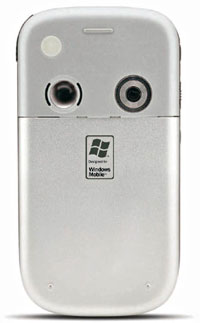 Performance
Performance Despite being billed as the “Killer-Sound Phone” by makers Pantech & Curitel, we’re happy to report that the PT-L1900 doesn’t emit a murderous noise beam, but is in fact a top notch music phone.
Despite being billed as the “Killer-Sound Phone” by makers Pantech & Curitel, we’re happy to report that the PT-L1900 doesn’t emit a murderous noise beam, but is in fact a top notch music phone. Back to the phone, the mid-size device (102X48X25.7mm) is dominated by a large, two inch, 240X320 pixels (QVGA), 262k colour TFT LCD display screen, with a slide out keyboard for phone functions.
Back to the phone, the mid-size device (102X48X25.7mm) is dominated by a large, two inch, 240X320 pixels (QVGA), 262k colour TFT LCD display screen, with a slide out keyboard for phone functions. The makers claim up to 190 hours of standby time and up to 3½ hours of talk time.
The makers claim up to 190 hours of standby time and up to 3½ hours of talk time.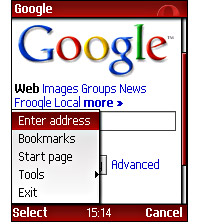 Opera Software have announced the worldwide release of
Opera Software have announced the worldwide release of  As a result of the compression technology, users can surf the Web faster – and those paying for their data traffic can dramatically reduce their bandwidth costs.
As a result of the compression technology, users can surf the Web faster – and those paying for their data traffic can dramatically reduce their bandwidth costs.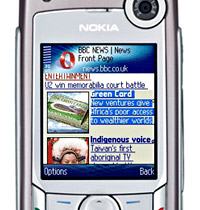 “With Opera Mini most people can start surfing the Web with the mobile phone they have today,” purred Jon S. von Tetzchner, CEO, Opera Software.
“With Opera Mini most people can start surfing the Web with the mobile phone they have today,” purred Jon S. von Tetzchner, CEO, Opera Software. Opera Mini can be freely downloaded by pointing your phone’s WAP browser in the direction of
Opera Mini can be freely downloaded by pointing your phone’s WAP browser in the direction of  Mobile operator 3 has launched an innovative service that, for the first time, pays customers to receive calls and texts.
Mobile operator 3 has launched an innovative service that, for the first time, pays customers to receive calls and texts.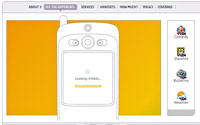 Designed to boost usage of data services, 3 also hopes that the cash-back scheme will prove attractive to new punters and tempt customers from other networks to switch.
Designed to boost usage of data services, 3 also hopes that the cash-back scheme will prove attractive to new punters and tempt customers from other networks to switch. The WePay top-ups come as all-cash vouchers available in £10, £15 and £20 denominations, with no expiry date. However, the WePay cash credits are only valid for 30 days.
The WePay top-ups come as all-cash vouchers available in £10, £15 and £20 denominations, with no expiry date. However, the WePay cash credits are only valid for 30 days.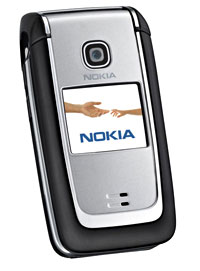 Nokia has shunted out a new addition to their mid-range mobile portfolio with the new Nokia 6125 clamshell phone, offering stereo audio streaming over Bluetooth and FM Radio.
Nokia has shunted out a new addition to their mid-range mobile portfolio with the new Nokia 6125 clamshell phone, offering stereo audio streaming over Bluetooth and FM Radio.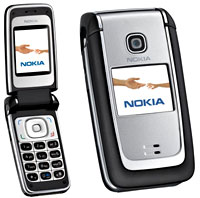 The quadband Nokia 6125 operates in GSM 850/900/1800/1900 networks and provides a flight mode, which enables the user to work with calendar or listen to music while on the flight – although we’ve heard of airlines like Virgin insisting that you turn off all phones – including those with ‘flight modes.’
The quadband Nokia 6125 operates in GSM 850/900/1800/1900 networks and provides a flight mode, which enables the user to work with calendar or listen to music while on the flight – although we’ve heard of airlines like Virgin insisting that you turn off all phones – including those with ‘flight modes.’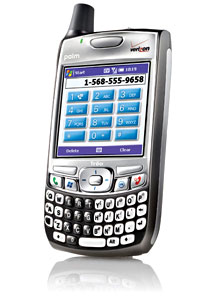 Palm have finally announced the launch of their much anticipated Windows Mobile powered Treo 700w smartphone.
Palm have finally announced the launch of their much anticipated Windows Mobile powered Treo 700w smartphone. The transition to Windows has, however, seen the TFT screen resolution shrink from Palm’s 320 x 320 pixels to a more miserly 240 x 240 pixels (the same as the Treo-alike HP iPAQ hw6500 series). Early reports suggest that the screen is somewhat washed out compared to the current Palm Treo 650.
The transition to Windows has, however, seen the TFT screen resolution shrink from Palm’s 320 x 320 pixels to a more miserly 240 x 240 pixels (the same as the Treo-alike HP iPAQ hw6500 series). Early reports suggest that the screen is somewhat washed out compared to the current Palm Treo 650.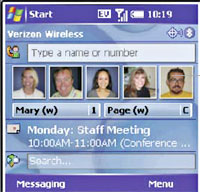 The removable battery gives up to 4.7 hours of talk time or up to 15 days of standby.
The removable battery gives up to 4.7 hours of talk time or up to 15 days of standby.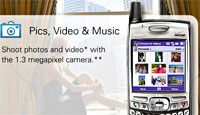 If Palm have successfully managed the transition to the Windows platform, we can expect this new smartphone to be a winner, although we do wonder what long-term impact it may have on their Palm OS range.
If Palm have successfully managed the transition to the Windows platform, we can expect this new smartphone to be a winner, although we do wonder what long-term impact it may have on their Palm OS range.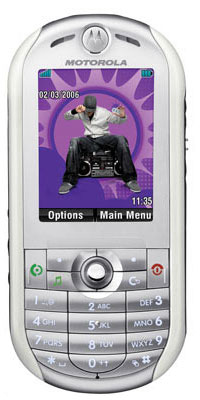 Motorola says adieu to Apple and bonjour to Linux as it unveiled its shiny new ROKR E2 phone at the Consumer Electronics Show today.
Motorola says adieu to Apple and bonjour to Linux as it unveiled its shiny new ROKR E2 phone at the Consumer Electronics Show today. Running on a new Linux-based operating system, the Motorola ROKR E2 also includes a high-res 320×240 screen, a 1.3 megapixel camera with video recording, a built-in FM radio, Opera Web browser Bluetooth (supporting wireless music streaming to stereo Bluetooth headphones), and joy-of-joys – a standard 3.5mm stereo headphone jack and not one of those ruddy annoying mini sockets that are incompatible with normal headphones.
Running on a new Linux-based operating system, the Motorola ROKR E2 also includes a high-res 320×240 screen, a 1.3 megapixel camera with video recording, a built-in FM radio, Opera Web browser Bluetooth (supporting wireless music streaming to stereo Bluetooth headphones), and joy-of-joys – a standard 3.5mm stereo headphone jack and not one of those ruddy annoying mini sockets that are incompatible with normal headphones.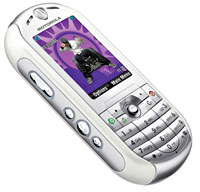 In the absence of iTunes, Motorola intends to push their iRadio Music Service, a subscription music service that uses mobile handsets as the base platform.
In the absence of iTunes, Motorola intends to push their iRadio Music Service, a subscription music service that uses mobile handsets as the base platform.